Table of Contents:
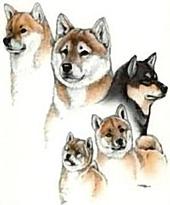
|
Table of Contents:
|

|
The NIPPO standard, developed in the thirties for the Japanese natural breeds, applied equally for all six breeds – it was intended to unite all physical characteristics of these breeds, so that they diverged only in their respective withers.
In the course of 60 years of intensive breeding, the breeders realised that the individual breeds partly differed from the original standard and it would be necessary to develop new standards better suited to the specific characteristics.
As with the other Japanese natural breeds the Shiba nowadays differs in appearance compared to the time when Dr. Saito discovered and described him for modern canine science.
Current Shiba breeding outside Japan complies with the FCI standard from 1992 which is derived from the Japanese standard.
Although the Japanese standard deviates just slightly and only in a few significant points from the FCI standard, the way of judging Shibas in their country of origin is different to outside Japan. The difference constitutes two fundamental points:
The following describes the interpretation of some points in the standard as referred to in bulletins and books by Japanese Shiba experts.
The first point in the Japanese standard concerns the "personality of the Shiba and its expression".
The personality of a show dog being judged in Japan counts for up to 15 of 100 possible points, with the highest rating being assigned to an intrinsic quality or characteristic. This illustrates the importance of the Shiba's character for the Japanese – in contrast to European or American judges or breeders.
Where the FCI standard mentions just briefly: a devoted, alert and above all a smart character, the NIPPO standard goes into much more detail.
The Japanese have three terms to characterise the Shiba's combined intrinsic qualities:
KAN'I: dauntlessness, audacity, courage
RYOSEI: good character
SOBOKU: naturalness, unaffectedness
A genuine dog belonging to the indigenous Japanese breed must have all these three qualities.
What does KAN'I mean? Kan'i is the most important quality of a Japanese breed. It means not only dauntlessness, audacity and courage, but also mental strength, harmony, balance and self-assurance. In Japan the male dogs stand vis-á-vis in a circle, like the Terriers in the USA. A male dog having kan'i confronts his competitor face to face with composure and looks him calmly and straight in the eye. He keeps his tail tightly in position. If the dog averts his eyes or allows his view to wander, the white of his eyes protrude or if he is unsettled or lets his tail droop, then he has no kan'i and will never get a good rating.
What does RYOSEI mean? The good character of a Shiba is a peace-loving, pleasant, faithful and obedient character. A good Shiba must be a good watchdog and companion – clever, easy to handle and companionable. He must have keen senses, but most of all he must be obedient and respect his master.
What does SOBOKU mean? Naturalness, vivacity, briskness, straightforwardness and spontaneity, that is the third essential aspect of the Shiba's personality. A good Shiba must not be obtrusive and affected, as many small breeds are, but above all he must not be uncouth or vulgar. Soboku indicates the dog's natural and intrinsic beauty and harmony.
The import of breeding specimens is complicated and sometimes frustrating. This has different reasons. Japanese dogs with the highest esteem and excellent show results do not correspond necessarily to the ideal of a beautiful Shiba outside Japan and their show results will never be repeated elsewhere. Furthermore they are unbelievably expensive, sometimes as much as 100,000 dollars.
 The general physical appearance and the basic body proportions
The general physical appearance and the basic body proportions
The NIPPO standard demands that male dogs as well as bitches have a well-balanced, proportionate body, well-developed muscles, a height to length ratio of 10:11 for male dogs, a little bit less for bitches. The height at withers for male dogs is 39.5 cm (15.55 in.) and 36.5 cm (14.37 in.) for bitches, with a tolerance of ±1,5 cm (±0.59 in.). The difference between male and female has to be visible at first glance.
The FCI standard has adopted this breed description, but does not stress the gender-specific differences (dimorphism). Likewise the height at withers has been scaled up a little bit – on an average of 40 cm (15.74 in.) for males, 37 cm (14.56 in.) for females.
For Japanese breeders and judges the Shiba's gender-specific shaping is of particular importance. Male dogs must be recognised immediately to be male – his bone structure must be stronger, his musculature tighter, the head big, broad and with outstanding cheekbones (like a filled bag) and with a short nose. The expression in his eyes and the bearing of his whole head must be self-confident and masculine. The bitch on the other hand must always have more delicate bones, less strong musculature and a slimmer torso. Her gaze and total bearing must be complaisant and soft. Irrespective of the height at withers a small male must be seen to be masculine and a big bitch must not appear coarse and masculine.
One more very important aspect in the description of the Shiba's physical appearance is the balance, proportionality and harmony of all parts of the body. The head also has to be elegantly proportioned, a harmonic interplay of size and shape of the nose, forehead, eyes and ears.
Long forelegs do not harmonise with a robust body, small ears do not go with a big, massive head. A male with a big head and sturdy shoulders, but with puny hindquarters is unbalanced and does not appear coordinated. A short buttock and straight limbs result in a deficient gait, making it appear uncoordinated. Only a completely regular, well-proportioned and well-coordinated Shiba has natural elegance and is capable of performing his tasks correctly.
In draft no. 1 the ideal ratio of the Shiba's single body parts is illustrated, just as the Japanese interpretation of the standard requires.
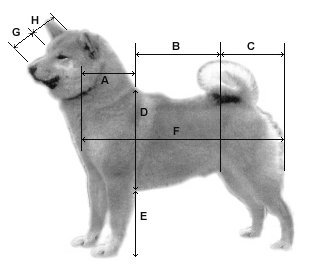
| 1) Ideal body proportions: |
| A: front body section |
| B: centre body section |
| C: back body section |
| D: depth of chest |
| E: elbow height from ground |
| E+D = height at withers |
| F: body size |
| G: size of nasal bridge |
| H: forehead size |
| H+G = skull size |
| Ideal ratios: | height at withers | 100% |
| body size | 110% | |
| circumference of carpus | 19-20% | |
| breadth of hips | 28-30% | |
| depth of chest | 45-50% | |
| volume of chest | 116-120% | |
| breadth of chest | 36-38% |
| If the body size is 100%, then the | front body section (A) amounts to | 28.5% |
| centre body section (B) amounts to | 43% | |
| back body section (C) amounts to | 28.5% | |
| If the skull size is 100%, then the | length of nasal bridge (G) amounts to | 40% |
| forehead size (H) amounts to | 60% | |
| breadth of cheeks amounts to | 56-58% |
The erect ears are a distinctive characteristic of the Shiba and their importance for the physical appearance should not be underestimated. Together with the tail carried over the back, the ears lend the Shiba his typical appearance and a dog having downcast ears can hardly be judged to be a Shiba.
The Shiba standard requires relatively small ears, but their size always has to be seen in proportion to the size of the head. Ears that are too big for one dog can be the correct size for another dog with a larger head. For this reason it is impossible to specify exactly the ideal ear length, as this must always be seen individually in relation to the dog's other proportions. There are more dogs with big ears than with too small ones.
The Shiba's ear has the shape of an isosceles triangle, with the equally long legs being formed from the sides of the auricle.
The most common fault concerning shape and set are ears set too far to the side of the head and sloping sidewards as well as ears set too near to each other and with tips turning towards each other. Ears set adequately, but without the triangular shape are considered to be the worst fault.
The Shiba's ears are moderately curved and rolled to smaller calyces. Less desirable, although not explicitly seen as a fault, are ears which are rolled to larger calyces, very narrow at the base and almost shaped to a tight tube. The opposite of rolled ears are completely open ears, flat and broad at the base. Extremely plain, open ears are less desirable than extremely closed ones, but the ideal is to be found somewhere in the middle between these extremes.
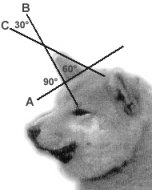 The standard specifies that the ears should slope forward slightly. If we express the slope of the ears in straight lines, the ideal proportion is as follows: elongating the head's vertex line on the straight line A, then the front of the ear B must form with this straight line an angle of 90°, i.e. stands vertically to the straight line A. The back of the ear C then forms together with the vertex line A an angle of 60°. The angle of the ear's tip C-B is 30°. Naturally these angles represent ideal conditions with a dead straight vertex head line. The Shiba's forehead often presents itself as slightly arched and therefore it is impossible to gage these angles.
The standard specifies that the ears should slope forward slightly. If we express the slope of the ears in straight lines, the ideal proportion is as follows: elongating the head's vertex line on the straight line A, then the front of the ear B must form with this straight line an angle of 90°, i.e. stands vertically to the straight line A. The back of the ear C then forms together with the vertex line A an angle of 60°. The angle of the ear's tip C-B is 30°. Naturally these angles represent ideal conditions with a dead straight vertex head line. The Shiba's forehead often presents itself as slightly arched and therefore it is impossible to gage these angles.
Many Shibas have more forward-sloping ears similar to the Akita, but more often Shibas have ears which are very upright and not slanting forward sufficiently.
Viewed from the front the ears must not sit too high nor too deep at the side of the head. If the ears are set too high, the space between them is too small and the Shiba's face loses its typical expression. If the ears are set too low, the vertex of the head ceases being flat and begins to look like a round, apple-shaped skull.
Viewed from the side the ears must neither be set too much to the front above the eyes nor be too widely set at the nape. If the ears are set too much to the front, you can see the line of the skull and in particular the prominent occiput comes to view. This means that there is no continuous line on the transition from the head to the neck. If the ears are too widely set at the back of the head, the dog has too high a forehead, extending from the eyes up to the ears. The head takes on a different shape and a simple-minded, sheep-like expression.
The position of the Shiba's ears shows not only his current mental condition, but also his character. A dog which runs, sits quietly or is bored usually keeps his ears half-slanted to the side of his head or even lets them drop into the nape. As soon as the dog pauses, becomes alert and starts to get interested, he has to hold his ears stiffly upright. Likewise a Shiba on presentation at a show has always to hold his ears upright and rolled forward – thus demonstrating his strength of character, his kan'i.
A Shiba with a bad character, fearful and servile, flattens his ears or jerks them – making his fear and subordination evident.
The Shiba's auricle cartilage should be relatively strong, the whole ear feels thick and very tight. Only ears with hard and strong cartilage can be held upright and stiff. Ears with thin, soft auricles are not desirable for a Shiba, on the other hand ears which are too strong are tolerated.
The shape of the Shiba's eyes is determined by the upper and lower lids, that means by the shape of the eye slits in a state of rest. The shape of the eyes has to be observed, when the dog is quiet and standing in the shade (when his eyes are in the shade). As soon as the dog is excited, watching prey or fixing an opponent, the lids start contracting to narrow slits. When at rest the Shiba's eyes are triangular, more open at the inner corners and narrower at the outer corners.
Small eyes are preferred on the Shiba. Eyes are very rarely too small or too deep-set, but more likely to be big, very open, round and prominent. Of all Japanese indigenous breeds the Shiba has relatively speaking the biggest eyes – this arises from the fact that the Shiba is the smallest dog of these breeds and the size of the eyeballs never decreases as is the case with the dog's dimensions, e.g. the withers at height. So the Shiba's eye in relation to his head is much bigger than e.g. the Akita's eye. Also for this reason with the Shiba the border between a correct and too big an eye is marginal, whereas the big breeds very rarely have eyes which are too big.
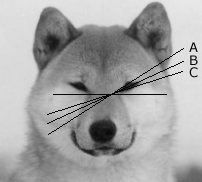 The position of the eyes is influenced by two factors – the distance of the eyes from each other and the angle at which they are set in the skull.
The position of the eyes is influenced by two factors – the distance of the eyes from each other and the angle at which they are set in the skull.
The picture illustrates correctly set eyes (B) – more slanted than on the Akita (C), but less slanted than on the other four Japanese breeds (A).
The distance of the eyes from each other lends the Shiba's face a different character. Narrowly set eyes give the impression of squinting, of quirkiness and baseness, whereas eyes positioned too widely make the face look empty, dull and non-intelligent.
The expression in the eyes is also important when judging the Shiba, even though the FCI remains silent on this item. The gaze of the male dog has to be self-confident even bold, agile, jolly and cheeky. It must reflect the male dog's high intelligence and good character. The bitch's gaze should be tender, subtle, jolly and agile, whereas an evasive, insecure or fearful gaze is considered as a fault indicating imperfect traits.
The head is a very significant part of the dog's outward appearance. It is not only decisive for the physical appearance, but also in two other respects:
a) the facial expression reflects the character and temperament of a dog
b) shape and strength lend the dog his gender-specific expression
In judging the head we want to account for its build (breadth, depth) as well as its expression as a manifestation of character, mood and temperament.
We divide the head into the forehead (topskull) and the foreface, i.e. muzzle and nose. The foreface reaches from the beginning of the nose leather up to the eye-line (stop). The skull of the forehead begins at the eye-line and reaches to the bulge at the nape. However neither the Shiba standard nor its Japanese interpretation defines exactly how long the head should be in proportion to the body, but requires that it should correspond to the dog's overall size and his gender. Important is the proportion of the foreface to the top skull which should be 40:60, that means the muzzle section should be a little bit shorter than the rest of the head. With the foreface we describe the breadth and length of the jaw, the shape of the nose (the upper nose-line), the flews, the colour of the nose leather and the content of the oral cavity.
The Shiba standard requires short, strong jaws as a fundament to the short and strong nose. With the bitch of course a more delicate nose is tolerated, but a tapered nose is considered faulty. It is desired that the foreface not only below the eyes but also at the tip of the nose should be strong, deep and broad, in profile round and from above slightly flattened. Viewed from the side the foreface has to be full and rounded. A nose viewed from the side which appears flat is a fault.
The Shiba's nose bridge has to be even, any other shape is considered to be a fault (a protruding nose as on the Pointer or the opposite, a concave nose-line ("downface") as on the Bull Terrier).
The Shiba's flews are dry, without wrinkles and free corners; they are relatively fleshy and set close to the jaw. The edges of the flews are dark pigmented.
The nose leather always has to be black, only on lighter dogs can less colouration be tolerated (the nose leather in such a case is not deep black, but grey).
The Shiba's jaws have to be connected to a scissor bite. The original standard tolerated all other types of bite – admissible on the Shiba were scissor, pincer and a slight undershot bite. An overshot bite was considered just as a slight fault. Later however only a pincer bite was considered to be correct and other types were declared faulty. Nevertheless there are Shibas today who have irregular jaws resulting from the fact that for a long time all bite types were tolerated.
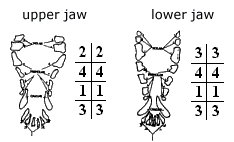 For the Japanese standard as well as for its interpretation the shape and size of the teeth are of particular importance. Required are strong, well-developed, large and healthy teeth. The standard does not stipulate the number of teeth and therefore there is no penalty at FCI shows for teeth with minor faults. In Japan as from approximately 1994 the Shiba requires a full set of teeth (see picture), and since then at a NIPPO show a dog with an incomplete bite can no longer be ranked as "excellent".
For the Japanese standard as well as for its interpretation the shape and size of the teeth are of particular importance. Required are strong, well-developed, large and healthy teeth. The standard does not stipulate the number of teeth and therefore there is no penalty at FCI shows for teeth with minor faults. In Japan as from approximately 1994 the Shiba requires a full set of teeth (see picture), and since then at a NIPPO show a dog with an incomplete bite can no longer be ranked as "excellent".
The Japanese standard requires that the mucous membranes inside the muzzle and the tongue of the Shiba are pink. Acceptable is a smaller number of black points on the tongue, but larger dark spots are considered as faults indicating a cross-breed of the Shiba with other breeds.
The Shiba's nose section should stretch to the cheeks and to the forehead. A nose disconnected from the cheekbones has a deficient shape and has to be rated as a fault.
Well-developed, bag-shaped cheeks determine the breadth of the head and give it its characteristic appearance. They are as typical for this breed as the hair line on the Rhodesian Ridgeback's back growing in the opposite direction to the rest of the coat or the Shar-Pei's wrinkles.
Viewed from the front the Shiba must give the impression of a hamster just having crammed its cheek pouches with food.
The Shiba has a clearly visible transition from the nose section to the forehead – the stop. This means that the Shiba's head must not run in a straight line (as e.g. on the Bull Terrier), nor show a too great a distance (as on the Boxer). The section between the Shiba's eyes is always depressed to the centre of the head and forms a slight wrinkle on the forehead. It is counted as a fault if this depression is missing (the area between the eyes is flat or bulges out). Likewise a too deep, inward furrow is not desirable.
The forehead of the Shiba is broad and deep and has to be flat on top. An domed head is a fault and has to be rated with a lower score. The vertex area always has to be parallel to the nose bridge (cf. figure 5), the stop area on the ideal head forms an angle of about 45° to the parallel.
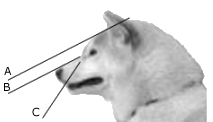 |
5) Head's profile:
|
||||||
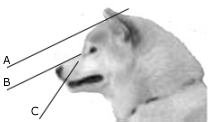 |
|
||||||
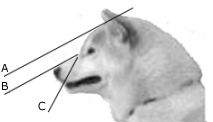 |
|
The Shiba's neck should be sturdy and muscular, because the set of his head and the whole stance depend on the neck's quality.
In alert position the Shiba keeps its head raised and the neck is very tense – its line forms together with the line of the back an angle of at least 50°.
The top of the neck, the crest of the neck, should always be slightly arched, forming a continuous elongation of the occiput and the line with the forwardly inclined ears.
The standard does not determine the length of the neck, but stipulates that it must be in harmony with the other body proportions.
The Shiba's neck is shorter than the neck of other medium-sized dogs of the Japanese breed, probably evolving from the fact that the Shiba used to move in a terrain, where a long neck would have been disadvantageous for him.
The skin at the neck must be tight and close and can form a double chin emphasising the cheek's size but it must not hang down to the throat and form a lobe.
The forelegs take up approximately half of the dog's withers at height and carry 60% of his overall weight (the hind legs account for 40%).
It is obvious that for the Shiba a good stance and a good gait depend on the correct angle as well as on the position and strength of the forelegs.
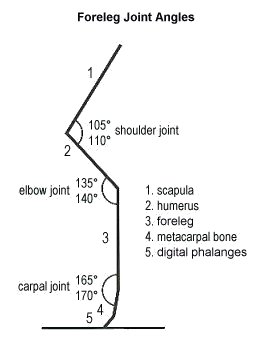 A Shiba should have legs with relatively strong bones and a well-developed musculature. Regarding the foreleg and hind leg an average angular position is desirable – neither too open, straight joints nor too narrow, angular joints. Well-developed, large, sloping shoulder blades, which together with the shoulder bones constitute an angle of about 105-110% should exist. The chest that we like on the Shiba should be formed from this angle of shoulder blades and shoulders, and the shoulder bones should be sufficiently backward sloping, so that the legs stand at the right angle. However, often you find Shibas with an insufficiently developed chest and shoulder joints which are too open. In this case the angle of the shoulder blades with the shoulders is bigger, namely 120-130% and the limbs are too straight giving the impression that they were positioned in front of the torso.
A Shiba should have legs with relatively strong bones and a well-developed musculature. Regarding the foreleg and hind leg an average angular position is desirable – neither too open, straight joints nor too narrow, angular joints. Well-developed, large, sloping shoulder blades, which together with the shoulder bones constitute an angle of about 105-110% should exist. The chest that we like on the Shiba should be formed from this angle of shoulder blades and shoulders, and the shoulder bones should be sufficiently backward sloping, so that the legs stand at the right angle. However, often you find Shibas with an insufficiently developed chest and shoulder joints which are too open. In this case the angle of the shoulder blades with the shoulders is bigger, namely 120-130% and the limbs are too straight giving the impression that they were positioned in front of the torso.
As long as this fairly straight angle is not combined with a faulty gait, it can be considered as not too serious a fault – it is just not desired. A bad stance is always judged as a fault, i.e. outwardly bent elbows which frequently occur in combination with further faults on the forelegs.
The Shiba's elbows have to cling to the body and must move directly forwards and backwards.
The forearms, that is the section from the elbow to the carpus, must be sturdy, always directed vertically to the ground and without visible bends or hunches. The stance of the legs – the distance from each other – is predetermined by the breadth of the chest and by the whole stature of the dog. From the breadth of the stance it can be recognized at a glance if the dog's bones are weak and the chest less developed = narrow stance, or if on the contrary the dog is too sturdy with a barrel chest = wide stance.
With the Shiba good movement is predetermined not only by the position of the shoulder blades and elbows, but also by the shape of the wrists (carpi) and the paws.
The wrists are slightly sloping so that the forelegs are cushioned when the dog bounds on hard ground, the paws must be round (cat's paws) with fixed, arched toes. Flat paws with less arched toes as well as open or stretched paws (rabbit's paws) are completely undesirable. The breadth of the forepaws is approximately a quarter larger than the hind paws.
The claws are solid and short. With correctly shaped paws they grind down by themselves and you do not have to pay special attention to them. Much favoured are darkly pigmented paws, but if the dog has bigger white markings on the legs, the pigment on the nails fades away and they become reddish.
The hind legs are the dog's driving motor, hence they have to be very strong and agile. Because only limbs with a correct angle and the right position guarantee strong motion in a forward direction, the Japanese standard sets store by the shape of the Shiba's hind legs. Any weakness or inadequacy of the position is considered as a serious fault.
A Shiba must not have too angular hind legs, but at the same time they must not be too straight.
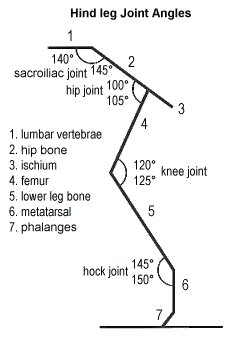 The ideal angle position is predetermined by the size of the angle between upper and lower thigh (knee joint) which should be approximately 120-125°, and by the angle of the heel (hock joint) which should be more open and approximately 145-150°.
The ideal angle position is predetermined by the size of the angle between upper and lower thigh (knee joint) which should be approximately 120-125°, and by the angle of the heel (hock joint) which should be more open and approximately 145-150°.
The most common fault of the hind legs is that they are too straight caused by an opening in all joints (hip joint, knee joint and hock joint). Unfortunately deficiently shaped joints on the hind legs sometimes with serious hereditary defects as well as insufficiently developed hip joints (hip dysplasia) and faulty shaped knee joints (patella luxation) occur.
Looking from behind at the hind legs you can detect some more stance deficiencies. Whilst a correct stance shows the legs pointing upright and at an adequate distance from each other to the ground, with some Shibas they stand in a narrow stance at close quarters (combined with a straight back and wimpy buttocks) or have deficiently shaped hocks (bent inwards, bent outwards).
Limbs with incorrect angles and poor position have a great influence on the Shiba's motion sequence. The Japanese require an easy, light, brisk and elegant movement, and they train their dogs before a show on courses of up to 20 km (12.42 miles) daily, so that they move more lightly in the ring and portray sportsmanship.
Because forelegs and hind legs coordinate in motion, their mutual harmony is indispensable. The angles of the forelegs have to correspond to those of the hind legs. If both pairs have the right angle, the movement cannot be other than correct. If the gait's angles are disparate, it is better for movement, if the forelegs are straighter and if the hind legs have a bigger angle than vice versa. Strong bones have a similarly large influence over the Shiba's movement depending on how muscular and long they are. The movement with too short a gait is never coordinated, likewise the movement with wimpy forelegs and too long or too sturdy hind legs.
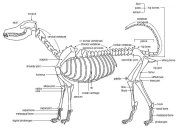 The Shiba's body consists of a relatively sturdy chest (it is said that its weight accounts for approximately 45-50% of the dog's overall weight), strong shoulders and a broad back. The back's top line has always to be straight and correspond to the dog's size and his gender-specific stature. The length of the body (measured on a horizontal line from the point of the prosternum, or breastbone, to the rear edge of the pelvis, the ischium tuberosity, commonly called the sitting bone) is slightly bigger than the withers at height (measured closely along the elbow), but the top line, that is what we see between the crest of the neck and the root of the tail, should comply ideally with the withers at height or be slightly shorter.
The Shiba's body consists of a relatively sturdy chest (it is said that its weight accounts for approximately 45-50% of the dog's overall weight), strong shoulders and a broad back. The back's top line has always to be straight and correspond to the dog's size and his gender-specific stature. The length of the body (measured on a horizontal line from the point of the prosternum, or breastbone, to the rear edge of the pelvis, the ischium tuberosity, commonly called the sitting bone) is slightly bigger than the withers at height (measured closely along the elbow), but the top line, that is what we see between the crest of the neck and the root of the tail, should comply ideally with the withers at height or be slightly shorter.
On the basis of draft 1 we see that the Japanese interpretation of the standard considers it as ideal if the length of the back (length of the torso's middle part + back part B+C) amounts to 71.5% of the overall length of the body.
If a male dog's height is 40 cm (15.74 in.), the ideal length of his body is 44 cm (17.32 in.) and the ideal top line is 28.6 cm (11.25 in.).
A male dog having ideal proportions gives the impression of a quadrate or a little bit less. Mostly the Shiba does not match this ideal measurement. There are dogs with larger frames, especially bitches. Naturally larger body frames are not particularly desirable, but they are not such a serious fault that a dog with other qualities and a good character would get a poorer rating. If the back is compact, sturdy and in compliance with the rest of the body, more length can be tolerated.
The most common insufficiency of the top line is the so-called carp back, where the top line is raised, with the highest point in the middle of the back. A carp back can result from a genetic malformation of the vertebrae or is often caused by a deterioration in the dog's healthy stance – a sick dog, suffering from parasites, cool and fearful, commonly has a carp back.
The opposite of a carp back is a sagging, soft top line which is – if it is not a congenital defect – prevalent on fat male dogs and on bitches who have been covered or used for breeding prematurely.
An important part of the dog's torso and half of the withers at height is the chest which on the Shiba must have an egg-shaped diameter (the top of the egg is on the first bone of the chest). On bitches a lank chest with flat flanks, a narrow and protuberant breastbone (sternum) and a sparsely muscular spine-like dorsal process of the vertebrae are often prevalent, which is very undesirable, because usually it is accompanied by a frail overall constitution.
A barrel chest with an almost circular diameter occurs predominantly on male dogs but here also such a chest should not be tolerated.
An important part of the chest is the forechest, that is the section in front of the forelegs. Its bone fundament is formed on the one side by the protuberance of the breastbone, on the other side by the elongation of the shoulder joints. A Shiba with a well-developed chest is preferred, correctly shaped and very muscular, which indicates good mounting and angle of the forelegs as well as a voluminous chest.
The dog's tail is, similar to the head, typical for the breed concerned and its shape completes the overall impression.
The Shiba's tail is as with the other five Japanese indigenous breeds set high, curled over the back, and rather thick and hairy. The tip of the tail must almost reach to the hook joint and any trace of shortening has to be considered as a deficiency.
The tail set high and clearly sloping enforces the impression of a compact dog and is important for the expression of his character. The dog only rarely uncurls his high tail. A tail set below the back's top line is not only deficient, but also unattractive. It is often badly shaped and also poorly carried and the dog drops it immediately at the slightest excitement. Especially a bitch with a low tail is at a disadvantage – many of them are psychically labile. A low-set tail is carried by bitches even lower and thereby they present themselves poorly at shows.
When judging the tail the Japanese conception differs only marginally from the FCI standard.

The FCI standard as well as the NIPPO standard declare: the tail is curled or sabre shaped. Ideally and most desirably the Japanese consider a tail to be curled to a single noose (1). According to their conception this means the height of beauty and expediency.
The Japanese prefer such a tail to a double or half noose.
With a double noose the Japanese prefer a type where the tail superposes the side of the back whereas a type 2 with the tail curled on the back is considered less desirable.
Also a sickle shaped tail (3) is possible, a saber shaped tail as type 4 is accepted as well.
Here we do not particularly differentiate between the different ways to curl the tail and on rating we pay more attention to the expediency for breeding.
Very undesirable is a tail which is too short. A dog with a shortened tail should no longer be used for breeding.
The advantage of a double curled tail is that it is always relatively long. A dog with a double noose, however carried, does not run the risk of being genetically burdened with a shortened tail.
Even though a sabre shaped tail conforms to the standard it is unaesthetic and a dog with such a tail will certainly not attract the judge's attention to such an extent that he will award him with a higher rank. The problem of sabre shaped tails is that they are normally short. When breeding, a dog with a sabre shaped tail should be coupled with a partner with a curled tail.
Concerning the Shiba's coat, its quality is of interest as well as the coat's spread on the body and its coloration.
The Shiba has a classical double coat, a so-called "stockhair" coat, composed of an outer coat which is fairly stiff and shining, with guard hair always straight, and the undercoat which is very thick, soft, dull and very greasy.
Due to the dense undercoat the guard hair on the Shiba's torso stands off from the skin at an angle of 45° or more. This special undercoat enables the Shiba to resist the rigors of the weather – rain, wind, snow and frost – without any problems and it is a huge problem for the owner, if he wants to bathe his Shiba. The healthy coat of a well-fed Shiba is never soaked by itself and has a large ability for self-cleaning.
The standard mentions no favoured length of the Shiba's coat, but this breed is classified as rather short-haired. Consequently all too long a coat is not desirable for any part of the body.
Shibas have their shortest coat on the face and at the gait, a longer coat on the torso and a slightly shorter on the neck and tail. On the tail the coat stands mostly straight, is fairly open and gives the impression of a stout tail. The Japanese say that the tail looks as if it is constantly being blown by the wind.
Considered as ideal is a so-called moss coat which gives the impression that the dog is cut out of foamed plastic. The Shiba's guard hair is almost as long as the undercoat, the coat is extremely dense and mostly stands straight from the skin. This coat sheds hair often because of the peculiarity that continually dead hair is replaced by new hair, the dog thus always being in good exhibition shape.
Basically Shibas can have three colours: red (genetically yellow!), sesame and "black and tan" (black with yellow markings) (see examples and The National Shiba Club of America).
The red colour of the coat has a large spectrum – it goes from clear, almost cream to crimson. Most frequently Shibas with red or rusty colouring prevail. Cream Shibas are rare, this colouration being less desired. Labelled as sesame are Shibas with a thin black shading of different intensity over the red ground colour. The shadings may vary, but red ground color especially in the undercoat must dominate.
Black dogs with red markings are less frequent than just red ones and also the specifications are stricter than with red specimens. It is undesirable if the red markings are too clear, but too luscious coloring – rusty – is considered faulty. Darkly coloured areas should be of luscious colour, so that the undercoat remains black. A clearer colour around the muzzle should be connected with a broad clear area in the chest region. It is undesirable that a red area around the muzzle is separated from the chest's red colour by a black coat.
Every Shiba must have "urajiro". Urajiro is a clearly coloured area of the coat to be found on the inside legs, on the chest, on the throat, around the muzzle (but not on the nose), above the eyes, on the belly and on the underside of the tail. Optically it sometimes looks white, nevertheless it is not white in the strict sense of the word. It is generated by a special modification factor which affects the red coat's colour and which has not yet been scientifically scrutinised. True white markings that can be found on the Shiba as well are caused by the so-called random albinism which is a spontaneous and absolutely irregular occurrence of white markings on a single-coloured animal. The white markings occur especially on the chest, on the paws, at the tip of the tail and on the throat. Neither the standard nor the Japanese interpretation speak of white markings, for them they are included in the term urajiro. What in fact is a genetic fault is convenient for us.
Considered as undesirable is a Shiba with a white-flecked area as well as the occurrence of white spots on the body. Spots on the throat is a controversial issue – some Japanese judges object to them, others consider them as permissible. Outside Japan they are tolerated.
A white face (a white nasal bridge and the whole section around the eyes up to the ears) or a sustainable black mask is always considered deficient. The Japanese maintain that they are a consequence of cross-breeding the Shiba with other breeds, mainly with the Mikawa Inu. A black mask, combined with aging, often occurs with the Shiba and is not considered defective.
Translated from the Czech by Holger Funk & Morag Elizabeth Peckelsen.
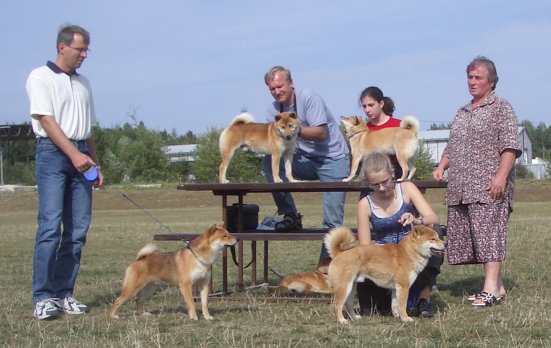
The author Hana Petrusová explaining the Shiba standard.

